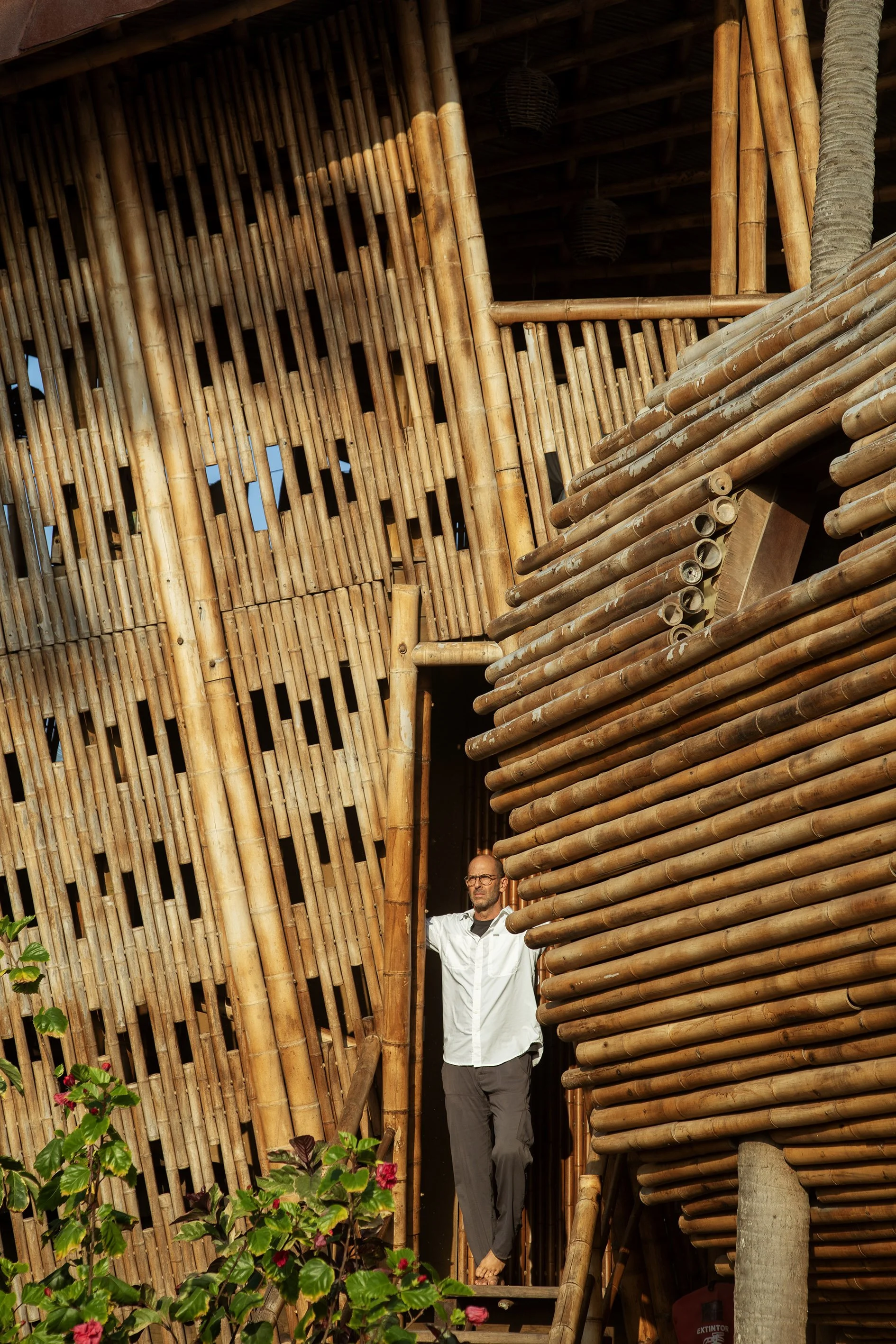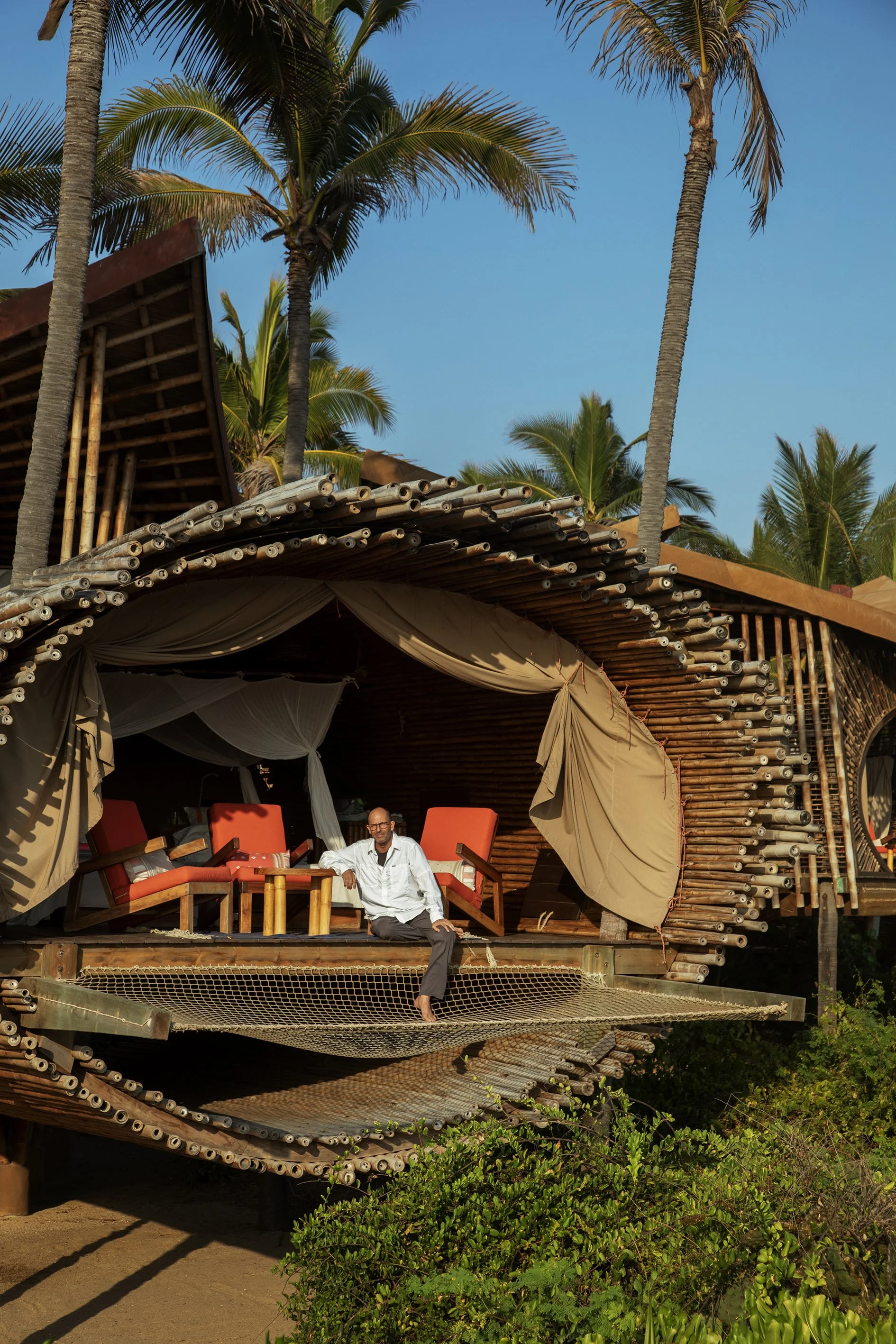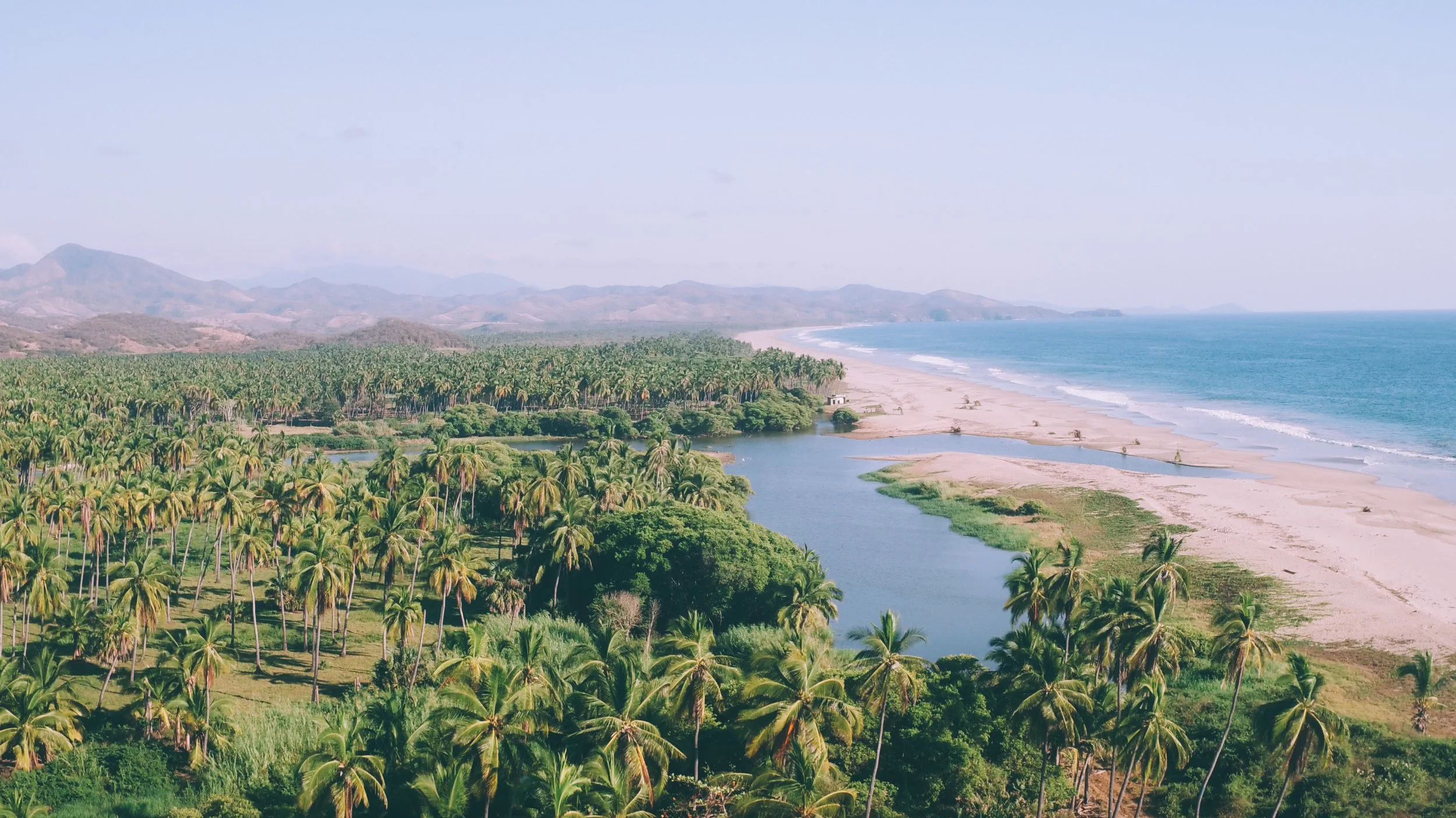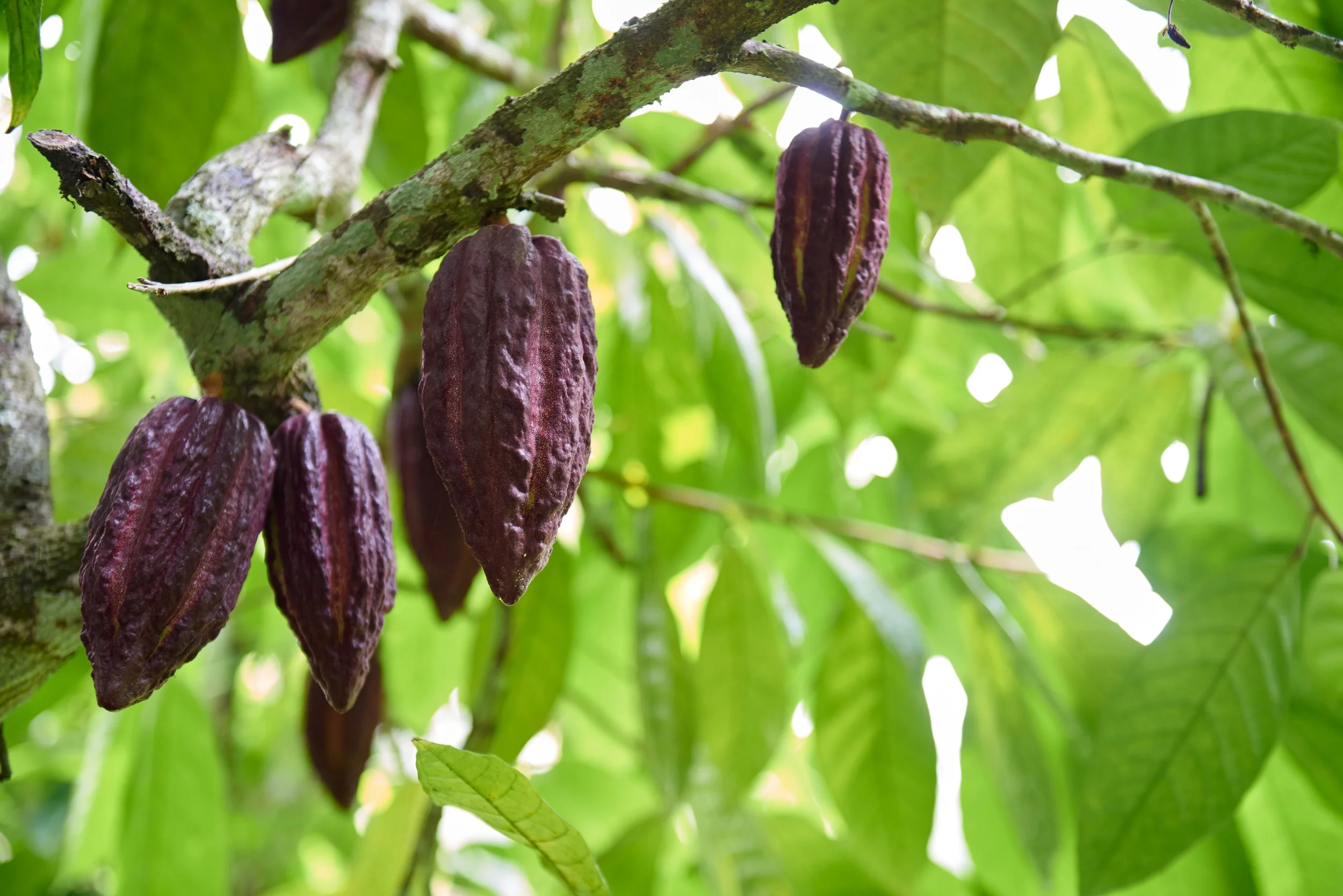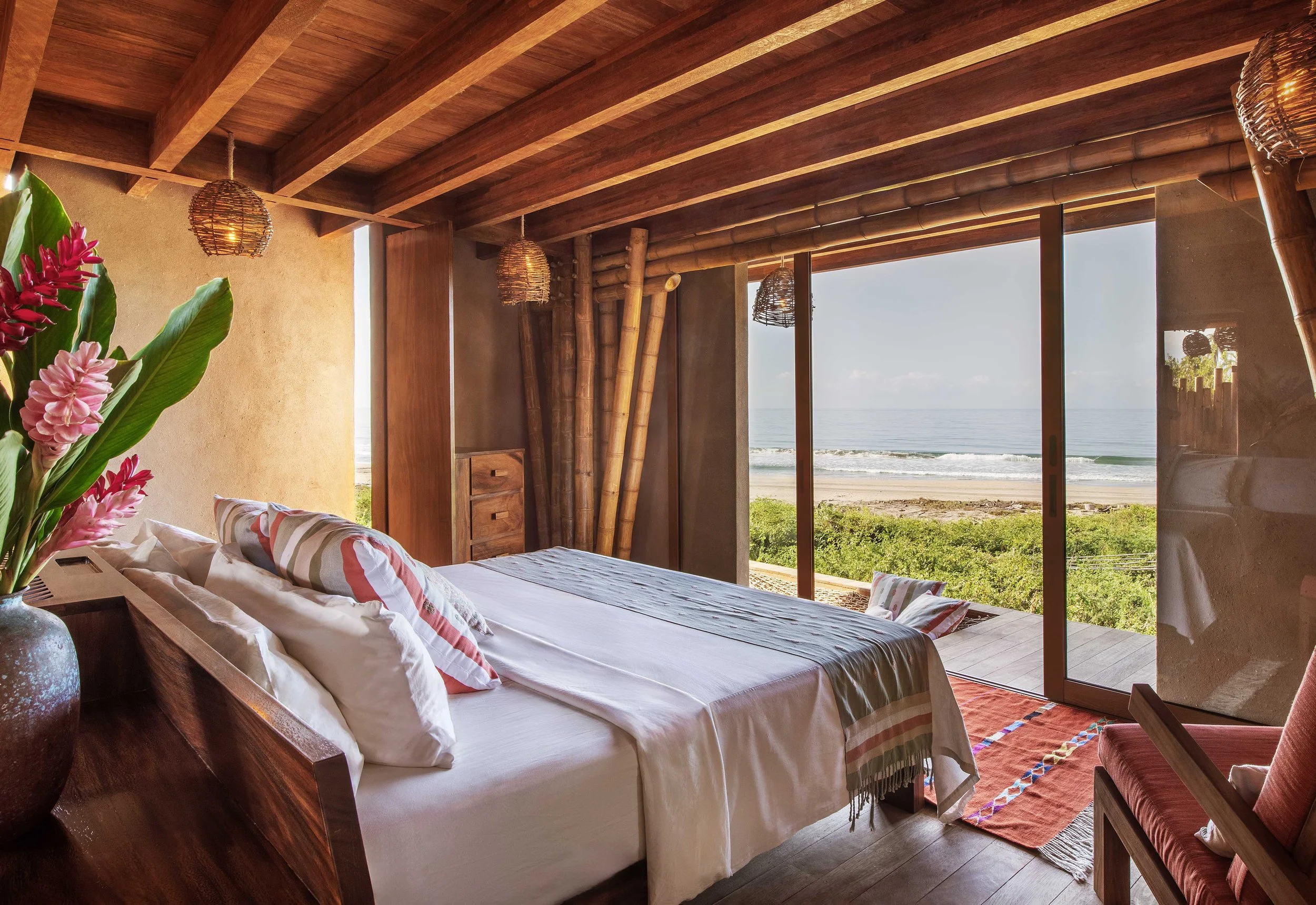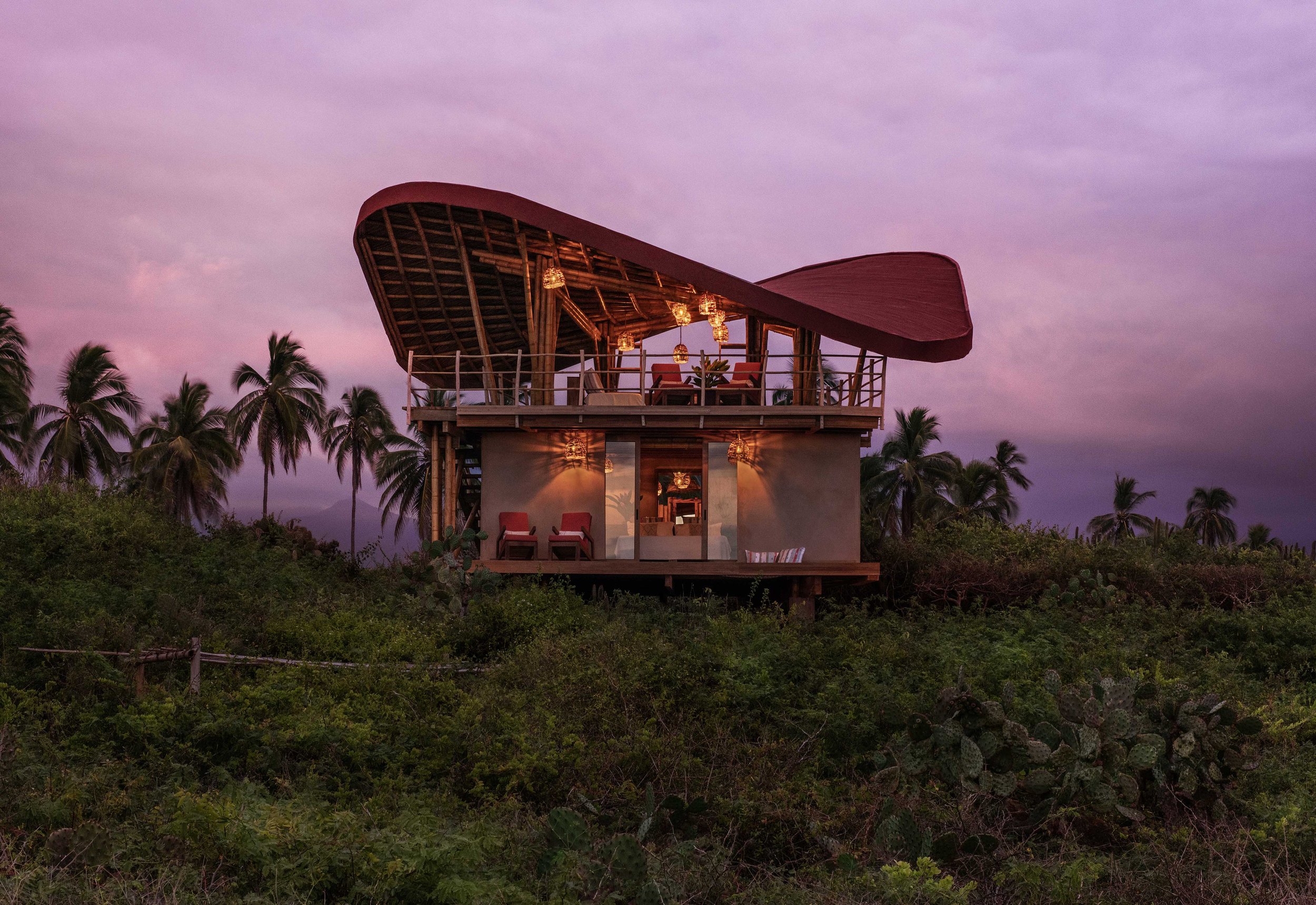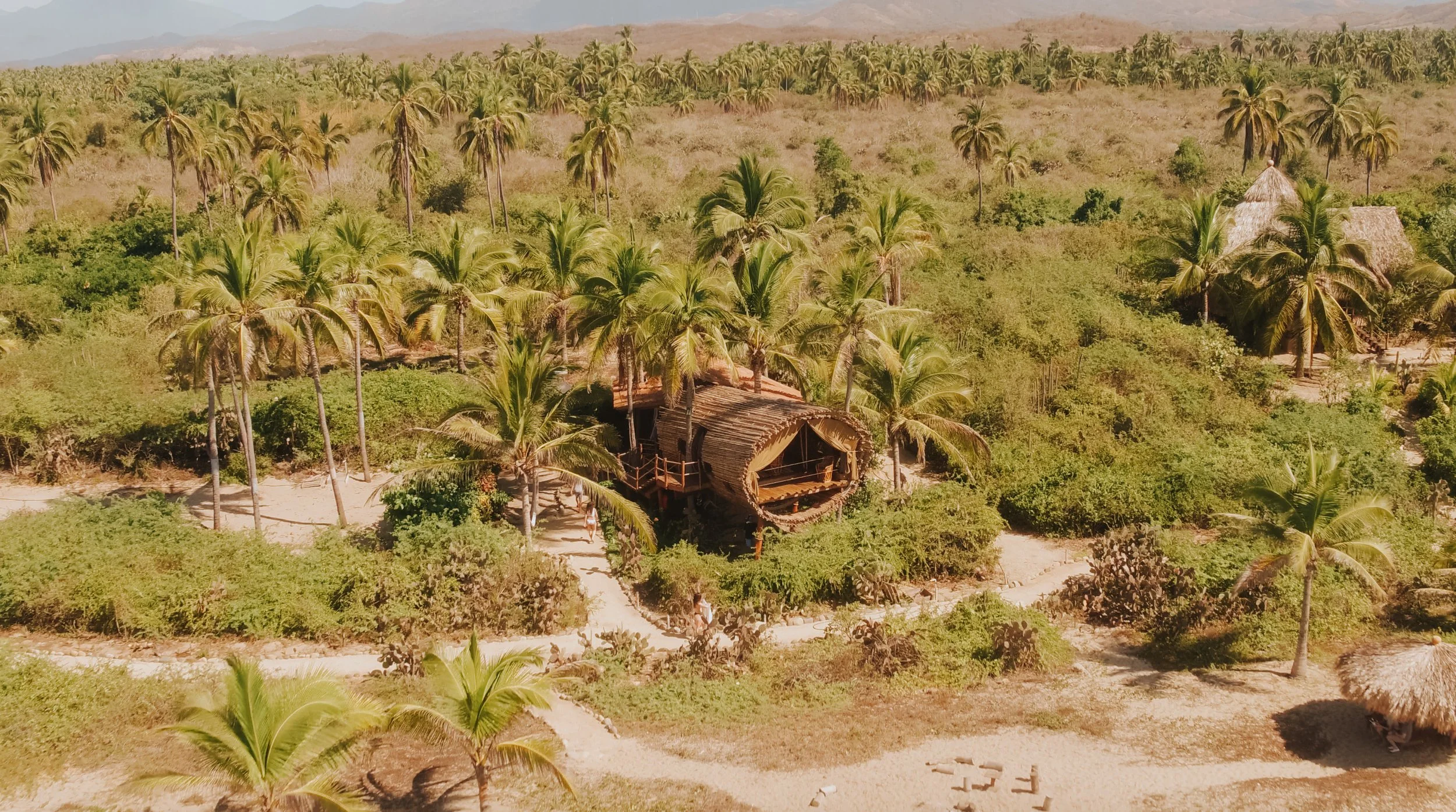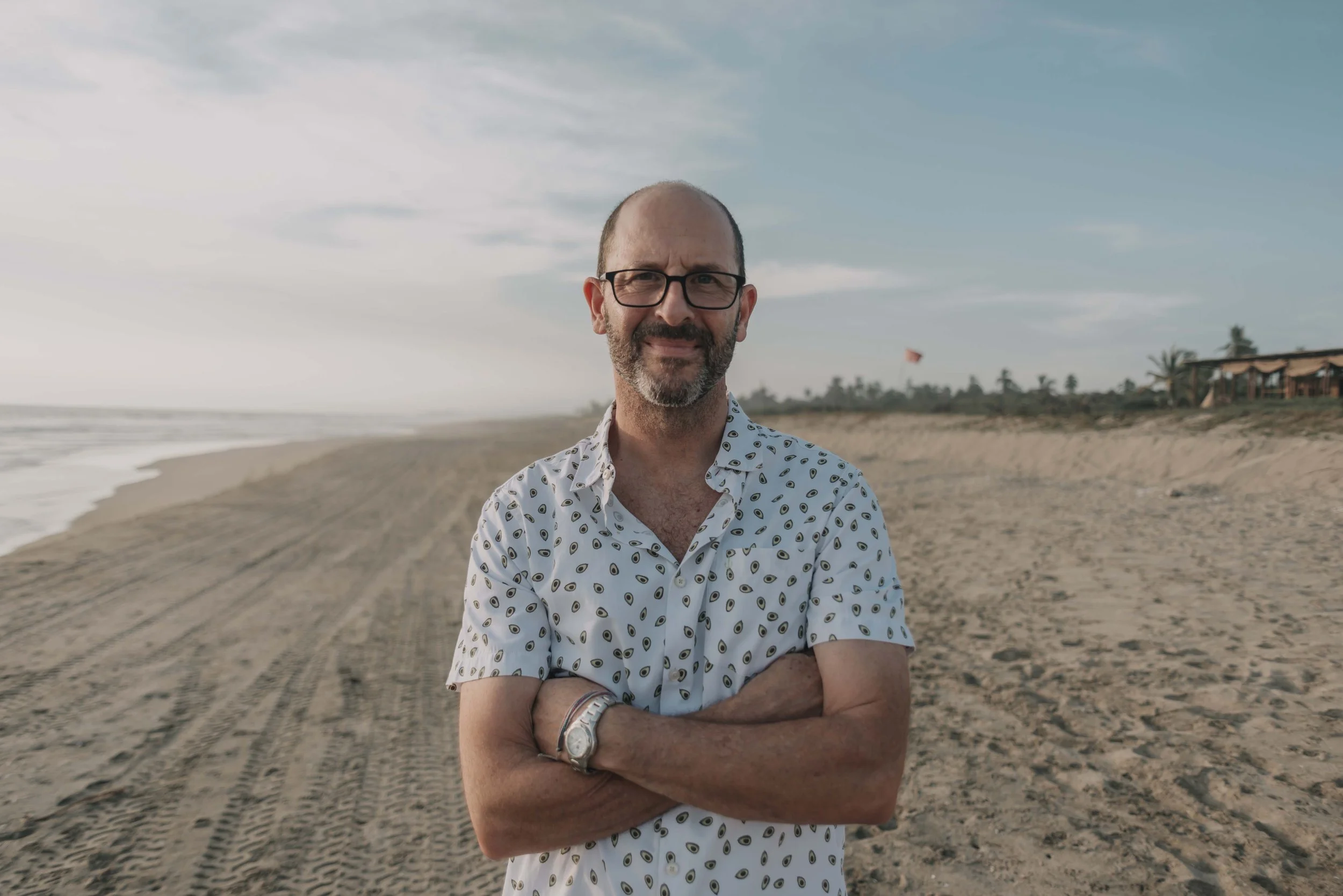Room and Wild Naturals: David Leventhal
Regeneration begins with empathy and with the understanding that before we can heal the environment, we must first care for the people who depend on it. Every landscape holds its own story of loss and renewal, and within those layers lies the blueprint for restoration. True transformation is not taught; it is felt. It happens in the moments that disarm us, watching hours-old turtles make their first, impossible journey toward the sea or witnessing fragility and strength coexist in a single breath. These quiet, tactile encounters return us to what is real and remind us what it means to belong to the living world.
David Leventhal is the co-founder of Regenerative Travel and the visionary behind Playa Viva, a pioneering eco-luxury resort on Mexico’s Pacific coast. His path began not in hospitality, but in conservation. Through his early work with Rainforest2Reef, Leventhal came to understand that protecting ecosystems requires more than drawing boundaries on a map. It demands empowering the people who live alongside them. This realization became the seed of his life’s work, creating models where travel restores rather than depletes, and where communities and nature thrive together.
When Leventhal first set foot on the land that would become Playa Viva, he approached it not as a developer, but as a listener. He studied its soil, water, wind, and human stories, mapping centuries of history across disciplines from the indigenous presence to modern land use. What emerged was a philosophy of design rooted in regeneration, one that treats every building, pathway, and guest experience as an opportunity to restore balance. Playa Viva’s architecture, community partnerships, and turtle sanctuary are all expressions of that original act of deep listening, a dialogue between people and place.
In R+W Naturals, we connect with extraordinary people making waves in sustainability, art, design, architecture, gastronomy, wellness, and wildlife — from travel and hospitality industry icons to acclaimed architects, designers, influential artists, forward-thinking musicians, boundary-pushing chefs and visionary explorers. We connected with David and discussed the transformation of tourism into a living system of reciprocity, respect, and renewal.
Today, Leventhal’s influence extends far beyond the shores of Playa Viva. Through Regenerative Travel, he has built a global network of properties united by purpose: to prove that hospitality can heal. His approach blends business acumen with ecological empathy, championing tourism that gives more than it takes and allowing visitors to witness regeneration made real.
R+W: Playa Viva began as a vision rooted in conservation corridors for species protection in the Yucatán. How did that early work with Rainforest2Reef shape your understanding of the link between protecting nature and supporting the communities that live alongside it?
DL: When we launched Rainforest2Reef, we held a myopic, purist view of conservation—believing that simply creating a protected area would safeguard everything within its boundaries. We quickly learned this was far from reality. As long as surrounding communities remain impoverished with limited economic opportunities beyond resource extraction, they will inevitably enter protected areas to illegally log timber, hunt jaguars for their pelts, and exploit other natural resources.
The paradigm shift toward linking social impact with conservation emerged through my collaboration with Shaun Paul, who led a non-profit organization integrating both conservation and social impact work in Guatemala. Our partnership fundamentally shaped my understanding that you must address the human challenges—social impact—before you can effectively tackle environmental problems. This became the cornerstone philosophy that would later define regenerative tourism.
“The paradigm shift toward linking social impact with conservation emerged through my collaboration with Shaun Paul, who led a non-profit organization integrating both conservation and social impact work in Guatemala. Our partnership fundamentally shaped my understanding that you must address the human challenges—social impact—before you can effectively tackle environmental problems. This became the cornerstone philosophy that would later define regenerative tourism.”
R+W: When you first arrived at Playa Viva's site, how did the history of this place—its people, land, and rhythms—inform every decision that followed?
DL: This question touches the very core of regenerative design and development. Understanding how a place has been degraded—which describes most locations where humans develop—reveals our role in regenerating that place and restoring its natural abundance.
“Understanding how a place has been degraded—which describes most locations where humans develop—reveals our role in regenerating that place and restoring its natural abundance.”
We employed a comprehensive systems approach, mapping the site's history across multiple disciplines: geographical, geological, biological, and anthropological perspectives spanning from indigenous peoples to current populations through oral histories. We studied soil composition, water patterns, wind currents, energy flows, solar and lunar cycles, and the natural movement patterns of both people and wildlife.
This multidisciplinary mapping revealed what previously existed where, and identified leverage points where our efforts could most effectively restore abundance. We designated zones for wilderness preservation, coastal forest restoration requiring over 10,000 tree plantings, mangrove rehabilitation, agricultural improvement, and optimal guest accommodation areas. This holistic understanding informed everything from building materials and supply chains to community engagement and turtle sanctuary support.
Most importantly, this deep listening process shaped our hotel program and guest experience design. It's an ongoing practice of paying attention to the results of our work and continuously refining our approach.
“This multidisciplinary mapping revealed what previously existed where, and identified leverage points where our efforts could most effectively restore abundance. We designated zones for wilderness preservation, coastal forest restoration requiring over 10,000 tree plantings, mangrove rehabilitation, agricultural improvement, and optimal guest accommodation areas. ”
R+W: Tourism often has a reputation for damaging wild places. How do you demonstrate that travel, done right, can actually fund rewilding, protect endangered species, and support local livelihoods?
DL: We face a fundamental choice in how we travel: Do we extract from destinations, or do we participate in regenerative travel that enhances the places we visit? When tourism engages in reciprocity with local ecosystems—both natural and human—and commits to regeneration, it becomes a powerful force for good.
Consider our popular "Fishing Expedition with the Locals" experience. While guests and guides typically return with a few fish and enjoy fresh oysters harvested during the trip, the deeper impact lies in economic transformation. The local fishermen who guide these experiences earn significantly more as cultural ambassadors than they would through fishing alone.
This means that without tourism, they would extract far more fish for far less income. Through regenerative, experiential tourism, these same fishermen extract fewer resources while earning better livelihoods and sharing their unique place and lifestyle with guests who develop genuine appreciation for their way of life.
The key is transitioning from quantity tourism to quality tourism—not exclusive, but inclusive systems that remain accessible to all based on their resources.
“We face a fundamental choice in how we travel: Do we extract from destinations, or do we participate in regenerative travel that enhances the places we visit? When tourism engages in reciprocity with local ecosystems—both natural and human—and commits to regeneration, it becomes a powerful force for good.”
R+W: Environmental problems are often people problems in disguise. How do you navigate the human psychology of conservation—our habits, resistance to change—when designing regenerative projects?
DL: Absolutely—this is a fundamental truth. The natural environment, left to itself, maintains perfect balance and self-regulation. Humans can serve as stewards of the land, embracing our unique role in caring for this extraordinary creation. Unfortunately, we've misinterpreted "dominion" as domination rather than stewardship, believing we have the right to extract, pollute, and destroy for personal benefit.
From a psychological perspective, I believe the only person we can truly change is ourselves, and our best contribution is modeling the change we wish to see. At Playa Viva, we don't preach about regeneration, sustainability, or environmental responsibility. Instead, we simply embody these principles, allowing guests to experience them naturally and realize they can integrate these practices into their own lives.
One of our core values is "Create Transformational Experiences," which we achieve through the lived experience of regenerative practices. Sustainability is a journey—none of us are perfect, but we're all capable of becoming more regenerative, more impactful, and less extractive.
“The key is consciousness—call it “woke,” “awake,” or “aware”—what matters most is recognizing that our actions, choices, spending, investments, and time directly contribute to either improving or degrading our world. What kind of legacy do you want to leave for the next generation? ”
The key is consciousness—call it "woke," "awake," or "aware"—what matters most is recognizing that our actions, choices, spending, investments, and time directly contribute to either improving or degrading our world. What kind of legacy do you want to leave for the next generation? Looking back, what will you say you did to leave this place better than you found it?
In essence: be the change you want to see in the world.
R+W: Regeneration represents a fundamental shift in how we perceive our role in the living world. What's the key to inspiring travelers to embrace this shift—not just visit, but truly participate?
DL: I'm not a purist who demands complete regenerative commitment or dismisses partial efforts. The most effective approach is leading by example and creating accessible opportunities for participation. We allow each person to find their entry point and comfort level, focusing on beginning the journey and committing to whatever level of positive impact they can sustain.
The transformation happens through experience, not lecture. When people feel empowered rather than judged, they're more likely to embrace lasting change.
“The transformation happens through experience, not lecture. When people feel empowered rather than judged, they’re more likely to embrace lasting change.”
R+W: Travel represents one of humanity's most powerful forms of education. What single lesson do you most hope guests carry home from Playa Viva?
DL: One of my favorite quotes comes from Anthony Bourdain: "Travel is not a reward for working, but education for living." The most important lesson I hope guests experience involves genuine engagement with our local community.
Photo by Kev Steele
Despite being an all-inclusive resort, our goal isn't to keep guests within hotel boundaries. We want them engaging with turtle sanctuary volunteers who protect these ancient creatures, working alongside farmers who cultivate their food, and connecting authentically with locals—fishing together, sharing meals, building real relationships.
That local human connection represents the most valuable education we can offer. It transforms guests from tourists into temporary community members, creating understanding that extends far beyond their stay.
“That local human connection represents the most valuable education we can offer. It transforms guests from tourists into temporary community members, creating understanding that extends far beyond their stay.”
R+W: The turtle camp at Playa Viva serves as a living classroom. How do guests respond to participating in hatchling releases, and what makes these moments so transformative?
DL: I've heard countless guests describe releasing baby turtles as "a life-changing experience." What creates such a profound impact? Perhaps it's witnessing the extraordinary fragility and vulnerability of these hours-old creatures, instinctively knowing to march toward the ocean. Watching these tiny beings forge headfirst into one of Earth's most powerful forces, knowing that only one in a thousand will survive to adulthood, makes you an eyewitness to an ancient, sacred struggle.
What I didn't recognize until years later is the beautiful reciprocity between guests and the turtle camp volunteers. After releasing turtles countless times, this profound experience can become routine for locals—as everyday as washing dishes. But when guests express how deeply the experience affects them, it transforms the ordinary back into something extraordinary. I like to hold on to the idea that I am a volunteer and, in doing so, I rediscover the specialness of both the experience and our role in it.
This reciprocity is pure gold hidden within our "living classroom" concept.
“I’ve heard countless guests describe releasing baby turtles as “a life-changing experience.” What creates such a profound impact? Perhaps it’s witnessing the extraordinary fragility and vulnerability of these hours-old creatures, instinctively knowing to march toward the ocean. Watching these tiny beings forge headfirst into one of Earth’s most powerful forces, knowing that only one in a thousand will survive to adulthood, makes you an eyewitness to an ancient, sacred struggle.”
R+W: You work at the intersection of business and ecology. How do you balance financial sustainability with deep ecological impact?
DL: You cannot achieve deep ecological impact without financial sustainability. Money represents a resource and energy flow as vital as any natural resource—from our time (limited and precious) to natural ecosystems like rivers, mangroves, and forests.
Playa Viva operates as a business in service of regenerating our local watershed and ecosystem, creating greater resilience for everyone. But we remain a business that can only continue this vital work by excelling at what we do. You can absolutely do good while doing well—Playa Viva serves as living proof of this principle.
Financial health enables environmental healing. They're not opposing forces, but complementary aspects of truly sustainable operations.
R+W: Playa Viva's architecture feels organically integrated with the landscape rather than imposed upon it. Can you share the design philosophy that guided construction, and how Regenesis Group helped weave regeneration into the very foundations?
DL: Regenerative design and development, as we learned from Regenesis Group, extends beyond historical mapping to seeking solutions that emerge from the place itself. Our land had previously been a coconut grove, and lead Regenesis architect Ayrie Cunliffe suggested we transplant existing palm trees from the orchard to ecologically sensitive sand dunes.
These transplanted palms serve dual purposes: creating a protective vegetative fabric for the dunes while functioning as living columns supporting treehouses directly on the beach. It took several years to perfect the transplantation technique, but once mastered, we developed our entire Manta Treehouse Village using living palm trees as structural foundation.
The Manta Village design itself was inspired by a squadron of manta rays we captured on video migrating just offshore. This approach allows nature to inspire architecture that is simultaneously luxurious, environmentally integrated, and genuinely fun to experience.
You can see more about building the Manta Treehouse Village in this short video.
R+W: As co-founder of Regenerative Travel, you've built a network of like-minded properties. What patterns do you observe among owners and communities truly committed to regeneration?
DL: Regenerative Travel encompasses diverse properties from remote beaches to urban environments. The common thread among all owners is deep connection to place—understanding what makes their location special and connecting guests meaningfully to local people and experiences.
Every property exists on its own journey, each becoming more sustainable and regenerative in unique ways. A tremendous benefit of the Regenerative Travel network is mutual learning and support.
Amanda Ho, our CEO, has done exceptional work with branding, ensuring the RT logo represents genuine quality assurance for guests seeking authentic experiences. When travelers see our mark, they know they'll encounter meaningful, transformative hospitality.
R+W: Looking ahead, what's your vision for the next decade of regenerative tourism, and how do you see Playa Viva evolving within it?
DL: Playa Viva functions as both a model and a learning laboratory. We continuously study other exceptional properties—for example, Fogo Island Inn's masterful community integration and transparent leadership through their Economic Nutritional Label. We're constantly improving our supply chain and governance transparency through B-Corp certification.
Our role is demonstrating that regenerative travel and tourism isn't just good for business—it's essential for local ecosystems, both planetary and human. As "regeneration" becomes mainstream, we face pressure around potential "regen-washing." However, advancing technology and the transparency it provides will serve as natural checks against both greenwashing and regen-washing.
“In 1982, John Naisbitt published “MegaTrends,” identifying “high tech/high touch” as a major trend—meaning the more technology dominates our lives, the greater our need for authentic, tactile experiences. Playa Viva and regenerative tourism deliver exactly this: high-touch experiences offering true “Immersion in the Luxury of Nature™”
David Leventhal by @Ana Lorenzana
In 1982, John Naisbitt published "MegaTrends," identifying "high tech/high touch" as a major trend—meaning the more technology dominates our lives, the greater our need for authentic, tactile experiences. Playa Viva and regenerative tourism deliver exactly this: high-touch experiences offering true "Immersion in the Luxury of Nature."™
The future belongs to travel that heals rather than harms, that connects rather than consumes, and that leaves destinations more vibrant than we found them.
Room + Wild is the world's first and leading collective and platform for landscape-enhanced accommodation, ecotourism, nature-based destinations, and sustainable luxury travel experiences. We consistently inspire, influence, and spread awareness through our tailored travel guides, curated media content/channels, brand activations, press trips as well as visual and narrative storytelling.



